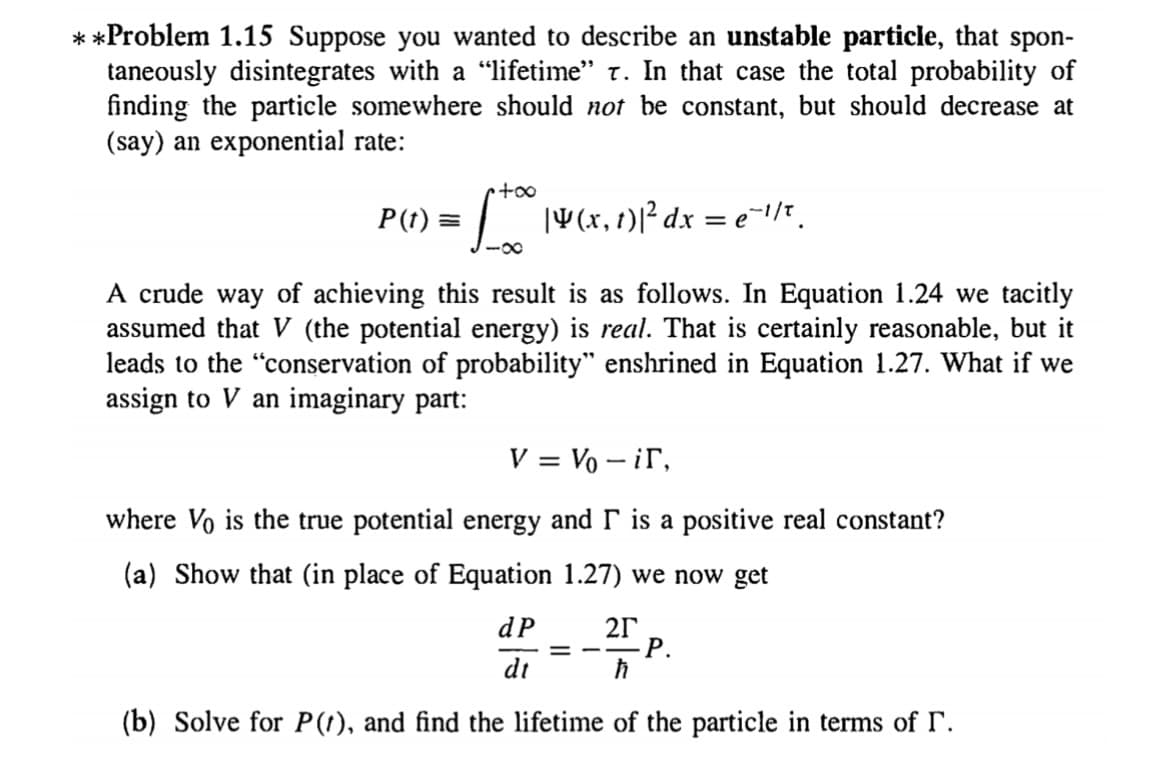**Problem 1.15 Suppose you wanted to describe an unstable particle, that spon- taneously disintegrates with a "lifetime" t. In that case the total probability of finding the particle somewhere should not be constant, but should decrease at (say) an exponential rate: too P(t) = | V(x, 1)1²dx = e~1/*. A crude way of achieving this result is as follows. In Equation 1.24 we tacitly assumed that V (the potential energy) is real. That is certainly reasonable, but it leads to the "conservation of probability" enshrined in Equation 1.27. What if we assign to V an imaginary part: V = Vo – ir, where Vo is the true potential energy and r is a positive real constant? (a) Show that (in place of Equation 1.27) we now get d P 2Г = -- P dt (b) Solve for P(t), and find the lifetime of the particle in terms of r.
**Problem 1.15 Suppose you wanted to describe an unstable particle, that spon- taneously disintegrates with a "lifetime" t. In that case the total probability of finding the particle somewhere should not be constant, but should decrease at (say) an exponential rate: too P(t) = | V(x, 1)1²dx = e~1/*. A crude way of achieving this result is as follows. In Equation 1.24 we tacitly assumed that V (the potential energy) is real. That is certainly reasonable, but it leads to the "conservation of probability" enshrined in Equation 1.27. What if we assign to V an imaginary part: V = Vo – ir, where Vo is the true potential energy and r is a positive real constant? (a) Show that (in place of Equation 1.27) we now get d P 2Г = -- P dt (b) Solve for P(t), and find the lifetime of the particle in terms of r.
Principles of Heat Transfer (Activate Learning with these NEW titles from Engineering!)
8th Edition
ISBN:9781305387102
Author:Kreith, Frank; Manglik, Raj M.
Publisher:Kreith, Frank; Manglik, Raj M.
Chapter5: Analysis Of Convection Heat Transfer
Section: Chapter Questions
Problem 5.8P
Related questions
Question

Transcribed Image Text:**Problem 1.15 Suppose you wanted to describe an unstable particle, that spon-
taneously disintegrates with a "lifetime" t. In that case the total probability of
finding the particle somewhere should not be constant, but should decrease at
(say) an exponential rate:
too
P(t) =
| V(x,1)1²dx = e=1/*.
-0-
A crude way of achieving this result is as follows. In Equation 1.24 we tacitly
assumed that V (the potential energy) is real. That is certainly reasonable, but it
leads to the "conservation of probability" enshrined in Equation 1.27. What if we
assign to V an imaginary part:
V = Vo – ir,
where Vo is the true potential energy and r is a positive real constant?
(a) Show that (in place of Equation 1.27) we now get
dP
21
= --P.
dt
(b) Solve for P(1), and find the lifetime of the particle in terms of r.
Expert Solution
This question has been solved!
Explore an expertly crafted, step-by-step solution for a thorough understanding of key concepts.
This is a popular solution!
Trending now
This is a popular solution!
Step by step
Solved in 2 steps with 2 images

Knowledge Booster
Learn more about
Need a deep-dive on the concept behind this application? Look no further. Learn more about this topic, mechanical-engineering and related others by exploring similar questions and additional content below.Recommended textbooks for you

Principles of Heat Transfer (Activate Learning wi…
Mechanical Engineering
ISBN:
9781305387102
Author:
Kreith, Frank; Manglik, Raj M.
Publisher:
Cengage Learning

Principles of Heat Transfer (Activate Learning wi…
Mechanical Engineering
ISBN:
9781305387102
Author:
Kreith, Frank; Manglik, Raj M.
Publisher:
Cengage Learning